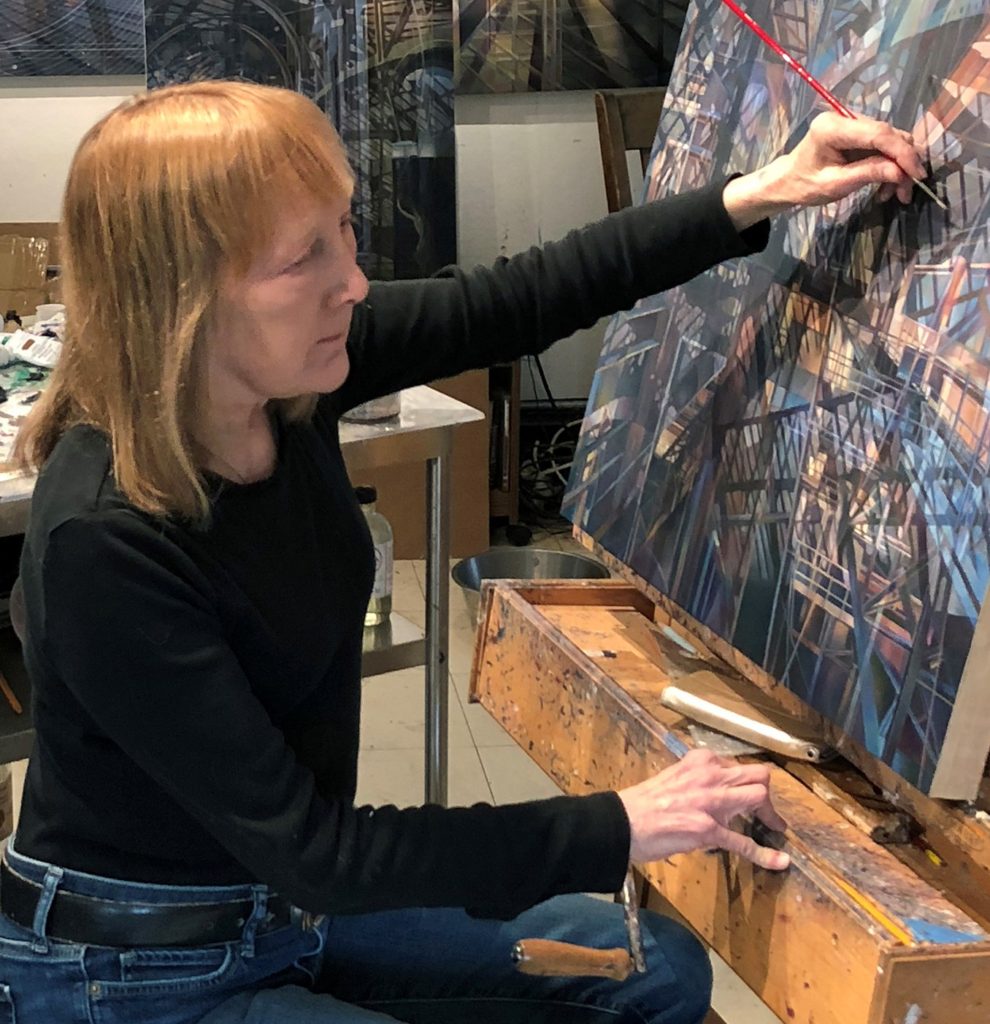Nancy Newmen-Rice Painter - St Louis, USA
Through lines, geometry, windows, parquet floors, staircases, contemporary buildings, gothic cathedrals, both internal and external, Nancy Newman Rice showcased them all in her art.
Zoneone Arts brings Nancy Newman Rice to you…
How did your residency to Paris after completing your MFA propel your art?
My residency in Paris happened 39 years after I received my MFA. Shortly after graduate school, I began teaching I at a city community college, St. Louis Community College, Forest Park, and an ex-urban university, Maryville University. The latter would offer me a full-time tenure track position. My husband was also in the early stages of his academic career and we had one young child, soon to be followed by another. Leaving home to participate in a residency was impossible, thus I waited until I took early retirement in order to not only paint full-time and also have the freedom to travel.
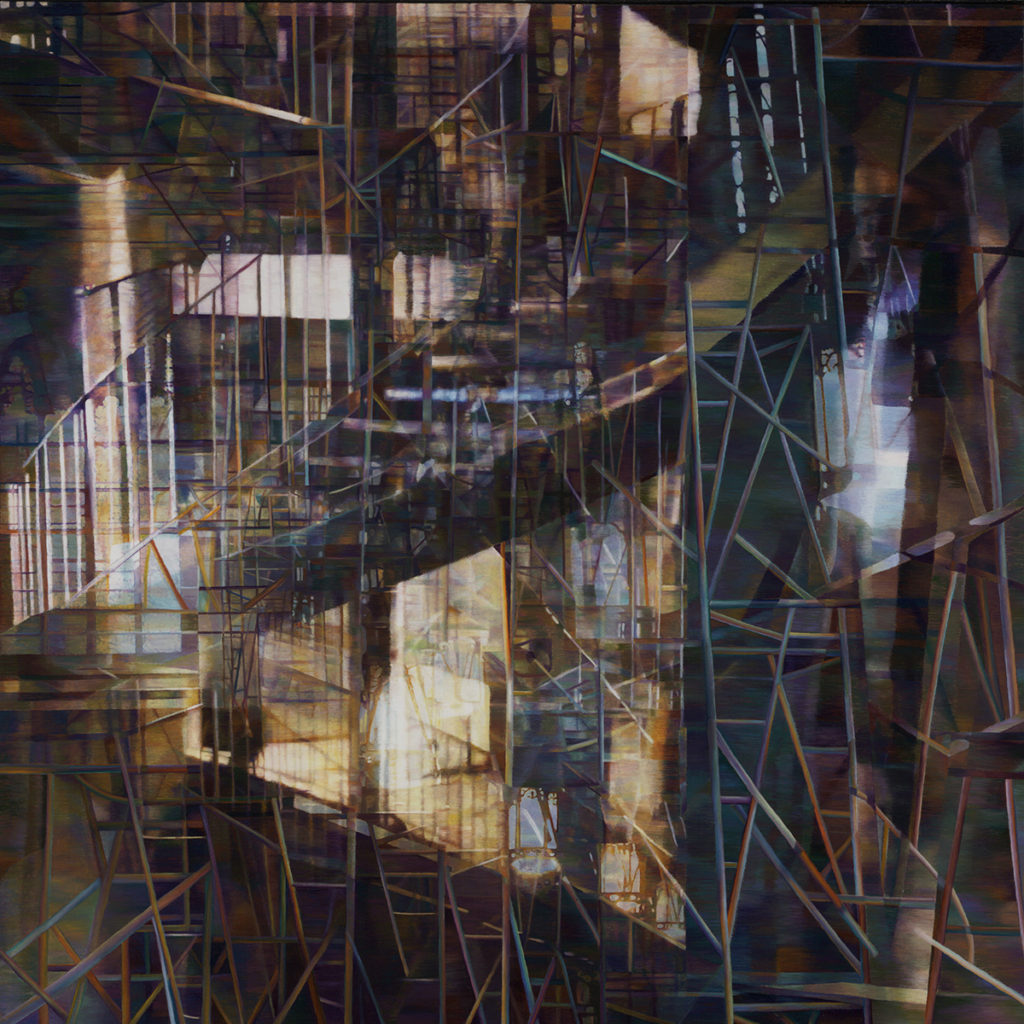
Ash Wednesday, 40×40” Oil on Canvas
Paris, a city like no other, has served as a subject and refuge for artists not only because it is beautiful but also because there is an aesthetic energy that seems to drive and effect he entire atmosphere. The essence of my application to La Cité des Beaux Arts in Paris, stated that my primary reason for wanting to live and work in Paris was to increase my collection of architectural imagery and experiences, by means of annotated drawings and photographs of the built environment. My days there, alternated with multiple visits to museums, cathedrals, churches and significant buildings, where I drew, when possible, or quickly photographed, and work in my studio. I collected images of windows, parquet floors, gothic cathedrals, (inside and out), and fantastic staircases. The spiral staircase in the Palais de Tokyo, which was at that time, a somewhat rundown cement commercial structure with countless of installation art opportunities. This staircase became an important element in my Ash Wednesday series, which was based on T.S.Eliot’s poem of the same name. The rhythm of the poem is one of climbing a spiral staircase each step a with reference to Catholic liturgy.
Your work has been represented by many commercial galleries in the USA, are there any collectors that standout?
I am fortunate in that I have been represented by commercial galleries, which have regularly exhibited my work. When my work was less complex, I was more prolific and able to have work exhibited in galleries around the US. Presently, my primary gallery, Duane Reed Gallery, exhibits my work in St. Louis and at international art fairs. Walter Wickiser Gallery represents my work in NYC.
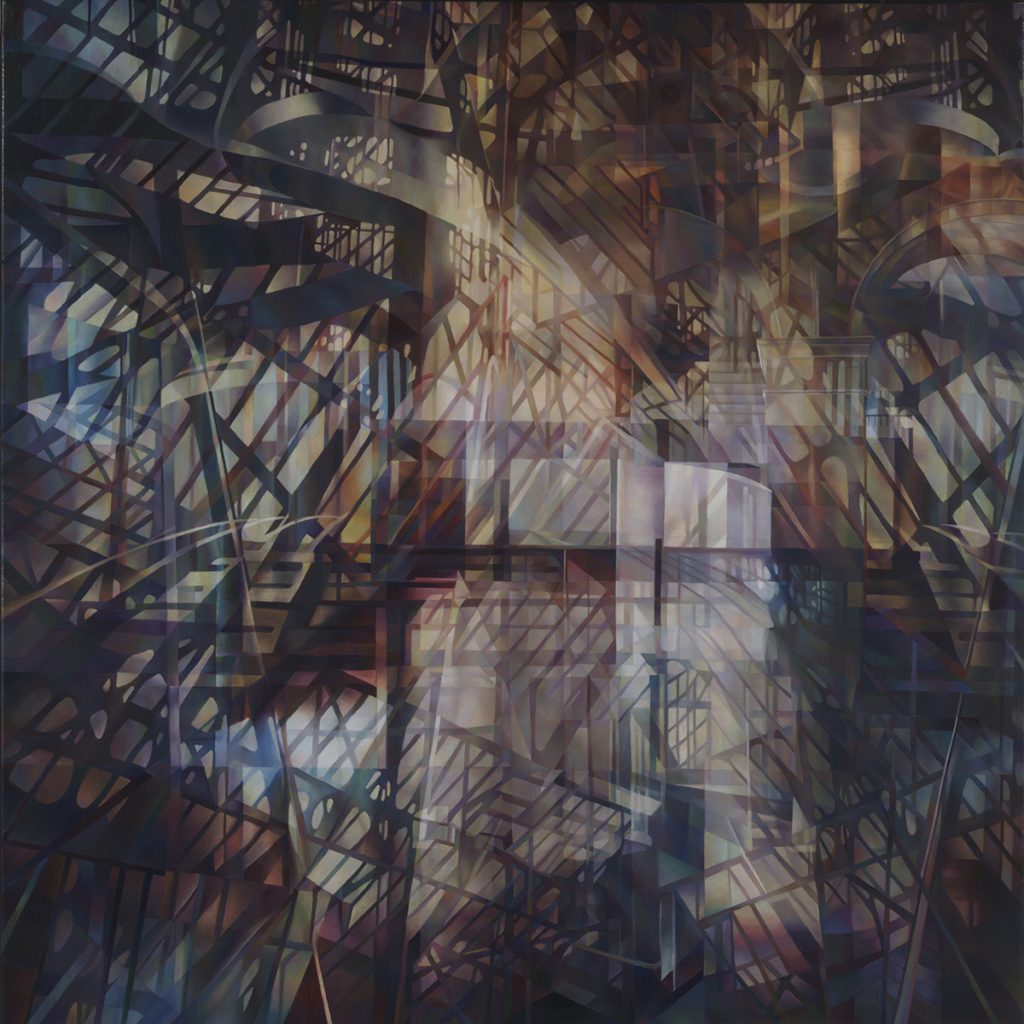
Parallel Place, 40×40” Oil on Canvas
What lead you to architectural landscape painting?
The simplest answer to the question, “why architecture?” it is my fascination with the geometry of the visible world and how we mortals have created our own geometric spaces in which to live, worship, learn etc.
I have lived in a city most of life and when I travel, I spend much of my time in cities, remembering events and where they took place is significant, and always involves a specific building and all the architectural elements that define its shape and interior space. My paintings are an amalgamation of those memories.
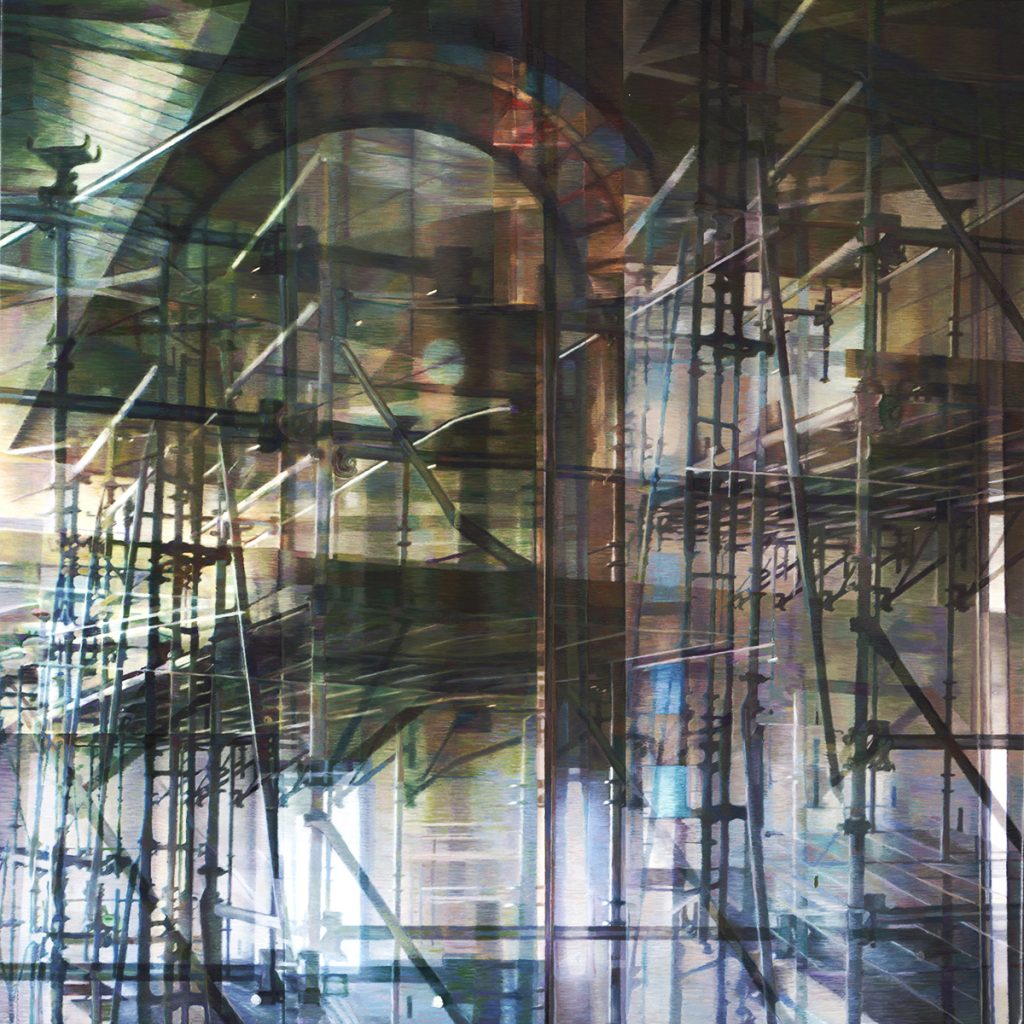
Arch with Scaffolding, 20×20, Oil on canvas
The evolution of my focus on architecture can best be explained as follows:
My husband’s PhD. Thesis was in differential Geometry, and his thesis advisor, a Jesuit, stated that God was a geometer. (He soon after left the Society of Jesus) I have to concur with him, as well as Cezanne, who said, “treat nature by the cylinder, the sphere, and the cone…”
My first years following graduate school, I painted floating masses of rotating dodecahedrons with translucent planes. I drew them first using linear perspective and became especially enamored with the construction lines, which I have never forgotten. My work evolved into patterns found in nature with an attention to fractal geometry. Eventually, I returned to plane geometry focusing on reflections and shadows as they define a room or a building. One of my earliest memories was tracking the passage of time as I watched a reflection move across the walls of our apartment in New York City, (typically three year olds were not roaming the streets of NYC). This early memory has affected my architectural paintings; illustrate the passage of time via the movements of shadows. Other compelling influences were the intricate patterns created by scaffolds and grid-like girders of unfinished buildings, these never ceased to draw my attention.
I collected photographs from newspapers referencing construction sites and among them was a small photograph in the New York Times of the interior of St. John the Divine Cathedral with a series of scaffolds inside the nave. It occurred to me that I could define interior space using the geometric framework provided by scaffolds. I did many graphite drawings from this photograph and finally a small painting on paper.
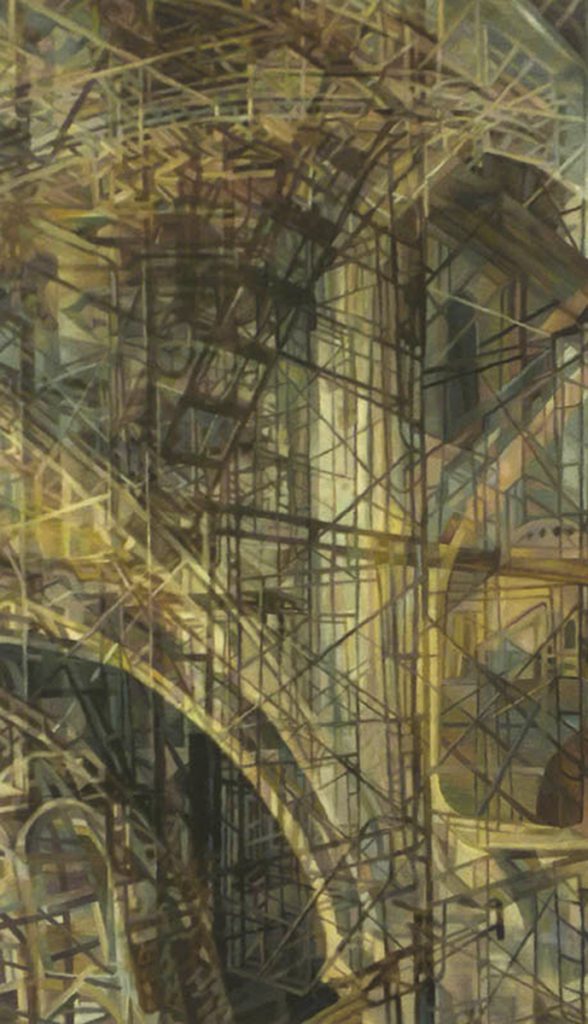
St John the Divine with Scaffolding, 14×17” Oil on canvas
My husband and I travel wherever he has an international conference, which gives me time to photograph and sketch a myriad of building styles. Initially these were the interiors of sacred spaces, churches, mosques, and cathedrals, into which, I constructed scaffolds that added a complexity to the space and a skeleton of sorts. For a while the buildings disappeared and I painted the remaining scaffolds, which were reminiscent of the skeletons that remain when a living creature dies.
My newest work is derived from a more recent collection of drawings and photographs depicting buildings. While looking through them I began to think about the liminal process of entering and passing through these spaces, drawing-by-drawing, geometric plane by geometric plane. I explain the resulting visual experience as a collection of built environments that define time, space, and motion, as my intention is to present each layer of architectural elements, shadows and reflections as if the viewer was visibly moving through time with me, or more graphically, what the nude sees as she slowly descends Duchamp’s staircase. I have geometrically deconstructed spaces, churches, train stations, airplane terminals, geodesic domes, and 19th century iron building façades, anything with a complex structure that lends itself to linear exploration. Some of the buildings are set against a night sky, a burning building, or a simple landscape and some of these settings become a significant part of the journey, others, not so much.
How do you use light in your work and how is it important?
Light is extremely important in my work, structurally and conceptually. It becomes the focal point as well as a method to define architectural structure via reflections and shadows. Although I am reluctant to discuss the spiritual implications of the light, briefly, it is meant to illuminate a path and a presence.
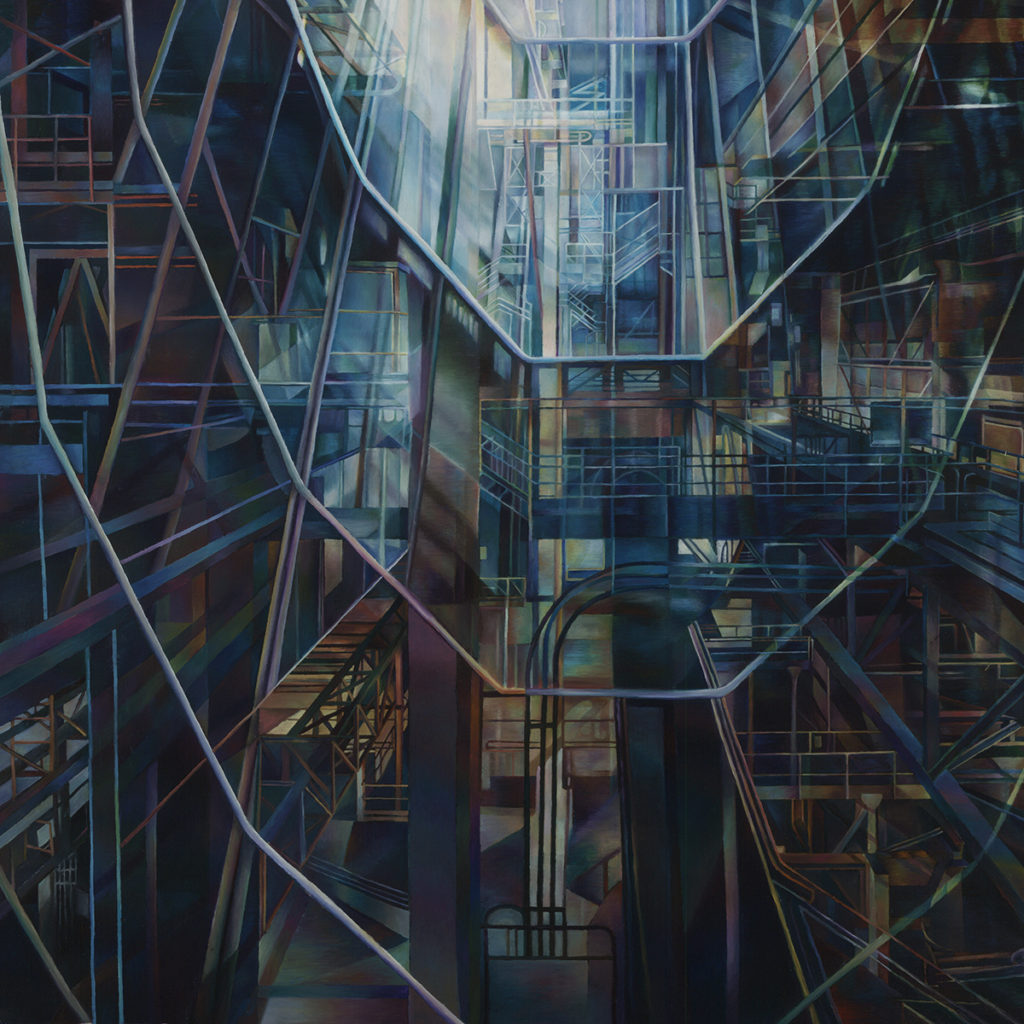
Ascent, 24×24” Oil on canvas
Discuss, line in your work
As I have mentioned earlier, the construction lines found in the perspective drawings, architectural drawings and mathematical models intrigue me; for the manner in which these complex collections of vectors intersect to form shape, mass, and structure and then continue on into infinite space, implies a sense of motion and time. Actually, the lines I paint are not done with machine-like precision; on close inspection the viewer can see that although they are straight, they are not perfect. I could use a ruling pen, but the result would be too machine-like; the difference between computer aided design and hand drafting and it is my hand that interprets what I see.
Your comment, “In my paintings the viewer observes but does not enter as the space is meant for contemplation rather than adventure?
In my artist’s statement, I write, “In my paintings the viewer observes but does not enter as the confusion of space is meant for contemplation rather than adventure.” There are a few exceptions, but for the most part my statement reflects the formal manner in which I construct space. Each layer may be translucent or transparent, and some depict receding site lines, but as the viewer moves from one plane to another, the realization sets in that the planes or memories are parallel to each other and could produce visual barriers, even though they are transparent or indistinct. Memories can also be impenetrable or unreadable for they are not always accurate, time is rearranged, aspects of one memory merge with another, and the result might produce an entirely new space. To further confound memory, are the places and events that reoccur in dreams rather than in our waking state.
You have written a book, “Fragile Memories”, tell us about the book
My book, Fragile Memories, was a sabbatical project. The university where I taught for 34 years required a specific project visits to sanitariums and beaches were not acceptable projects, even though well deserved. Because my work is derived from memories, writing about them, based upon my paintings, was an exercise in introspection as well as observation. A painting depicting the pattern of ocean waves, reminded me of my immigrant past, another with multiple shadows and two empty chairs visually translated into what remains when conversations or interactions are over. Ultimately, the chairs are standing in for people who are no longer here. My book also contains references to my children as well as remembered moments and observations.

Fragile Memories, Cover
Discuss your involvement with Mark Narins: the collaboration, the music and its effect on your work
Collaboration:
My collaboration with Mark Narins came about through social media. Mark, a friend from high school, was struck by a painting I posted on Facebook and it inspired him to create a musical composition based on his interpretation. He sent me a written version of what he understood to be the story behind the painting. His description was amazingly accurate and I am convinced that sensitive artists in any field are capable of understanding each other’s work if they are compelled to do so.
The music and its effect on your work:
The effect of Mark’s compositions, both musical and written, derived from my painting has provided the impetus to begin another book.
As an aside, I am one of those bizarre people with synesthesia, when I concentrate on a piece of music; I visualize lines that form patterns. For example, Bach’s Inventions create a very regular geometric pattern of connecting squares. The pattern becomes dense as the notes speed up, and less condensed as the notes return to the original theme. Notes in the Treble clef become small squares while notes in the bass clef expand.
I cannot listen to music when I paint, as it either interferes with my process or evokes memories that interfere with my ability to concentrate. I listen to books on tape, but not until the drawing has been completed and the colours established.
The audience reaction to the presentation
I was not present for the performance of Mark’s composition, but he sent me a recording, which I listened to several times. The tonal nuances seemed to coalesce with the subtle changes of colour and shifting planes of my panting which was projected on a screen behind the members of the orchestra. I never cease to be amazed by the ephemeral nature of music and how composers, like Mark Narins, transpose patterns of notes that may or may not refer to a narrative, into a time driven art form that only exists when it is played,
Discuss using two paintings, very different architectural spaces.
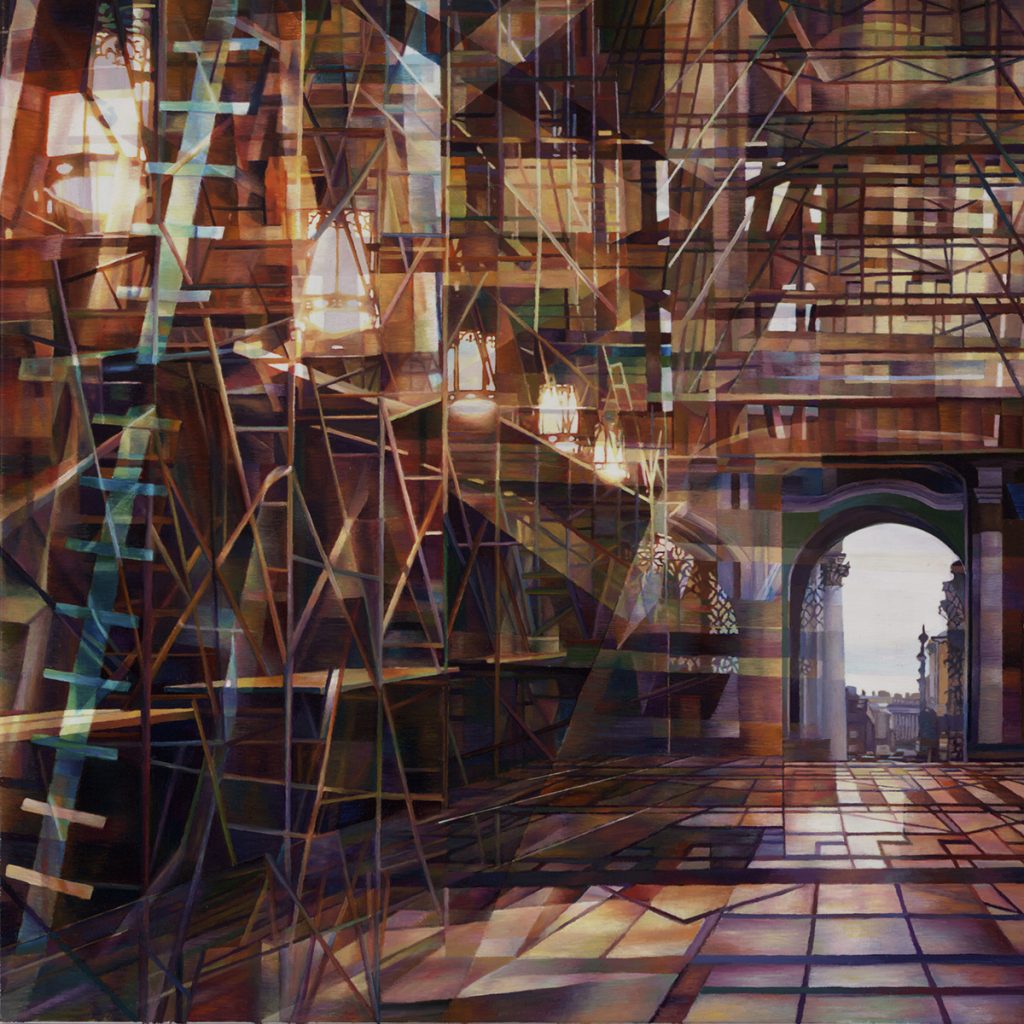
Journey, 20×20, Oil on canvas
My paintings are based on two different foci. The paintings such as Journey depict a deep space with an opening for escape, these paintings are about passing through a space and invite the viewer to run or meander through veils of colour.
–Tribute to Ferlighetti, present the viewer with a densely packed shallow space, permitting the viewer either an overwhelming glance at a haphazard arrangement of memories or the opportunity to investigate visual elements and their relationship to time, space, and light.
Composition:
The composition came about rapidly, which is how my mind works some days, other times I slog through many iterations of one image. In composing a painting, I often repeat a drawing I have used before in combination with others to produce an aesthetic effect, and/or enhance a somewhat arcane narrative; Unquiet Mind is an example of both methods.

Coney Island of the Mind, 40×40”Oil on canvas
Colour:
The colour in this painting contains red, which in prior work has been absent or muted. For me, red is a disturbing and aggressive color; the red girders in this painting are threatening and either challenge the viewer to venture in or flee.
Light:
The light is scattered throughout the painting indicating multiple sources of escape or refuge.
Size:
The size, 24”x24” is practical, because it is the largest size I can paint in a month. All my paintings are square, for me, the square represents a perfect balance and source of containment for the complex constructions within.
I will add, that this painting is now in the collection of two psychiatrists in the UK.
How does your own physical environment influence your work?
My physical environment does influence my work especially the changing light throughout the seasons as it produces the shadows, reflections, and changes in colour all of which have an impact on my work. For example, a pattern I use in several of my paintings, a plane perforated by ovoid shapes comes directly from the reflection one of my studio lights projects on the ceiling; I noticed it one evening and found beautiful.
Wherever I might be happen to be, I have noticed and recorded phenomena that others might find less interesting, (the camera app on my phone has been an invaluable tool.) For example, there was an intricate scaffold outside La Chappelle in Paris, and as I were taking photographs people stopped, wondering what was more amazing than the opulent stained glass windows inside the chapel. I have also photographed scaffolds inside St. Patrick’s in NYC during a, two year cleaning and renovation, the outside of Sainsbury wing of the National Gallery in London, and the outside of some of the storefronts in my neighbourhood. I also take photographs of landscapes, which I might use at some point, although I am not sure about the role they might play.
Can I ask you to walk us through your career, a (mini retrospective) using these paintings?
I will explain the sources of the following paintings, without discussing the technical aspects of composition and colour. The paintings take a month to complete, in the case of Reflected Space, three months. The drawings are altered; the colours change, and elements are added to make the paintings work formally. As I told many painting students during critiques, “You can talk a good painting, but can you paint it?”
2012, The Arch with Scaffolding:

The Arch with Scaffolding, 20×20″ Oil on canvas
This painting was derived from an interior arched doorway in a public building in Washington DC. The arch was comprised of brilliant stained glass, which memory faded. The scaffold was adapted from one I drew inside the Hirschorn Museum. I remember walking around it to get different views, hence the overlapping etc. These two structures became inseparable in my mind and unforgettable, unlike the numerous paintings of men in powdered wigs in the Portrait Gallery. I will add, that this painting is an example of a space the viewer cannot enter, can contemplate or simply deconstruct.
2013, Infinite Reflection:

Infinite Reflection, 40×40″ Oil on canvas
The drawing for this painting was completed in Paris during my residency in 2013. The drawing started with the interior of Notre Dame Cathedral, which was across the Seine from my studio. I did numerous drawings inside and out. (Drawing, in Paris, is apparently a spectator sport.) After choosing one drawing I began to fill it with invented scaffolding, based upon some of my scaffold drawings. During Mass in Notre Dame, I experienced the enormity of this space, even though it was replete with congregants, and history.
I had to fill the cavernous space, horror vacui? The viewer cannot enter this space but instead is invited to walk on an invented reflecting floor and approach the impenetrable wall of memories and dreams.
2015 Entrance:
 Entrance, 18×18″ Oil on canvas
Entrance, 18×18″ Oil on canvas
The paintings completed during 2015 followed my Ash Wednesday series, referred to earlier. After painting many versions of the spiral staircase, I became interested in progression through space via memories. Entrance is comprised of scaffolding, which has been moved against the walls, the arch from the Arch with Scaffolding discussed above, large windows from a glass interior, and a doorway leading to infinite space, or a place space imagined by the viewer. Doorways, portals and arches are ubiquitous in paintings of 2015; they provide a natural focus, not necessarily an end in the journey but rather an open door through which one could continue.
2017, Stargazing:

Stargazing, 20×20″ Oil on canvas
This painting is part of a series specifically based on the passage of time. These paintings are among the only ones in which I have included a figure. The figures are really the translucent shadows of someone who might have been there to witness the changing sky as the hours progressed. The cylindrical construction with windows comes from a photograph I took in the atrium of the Miami FLA airport. I changed it to accommodate my concept of a revolving machine-like structure that provides an observation deck on which to view the sky. I found a night sky image with geometric delineations, in a textbook. It reminded me of some of the World War II paraphernalia my uncles stored in my grandmother’s attic, my uncle’s army binoculars in particular. They had concentric circles used to measure distances. I cannot imagine infinite space nor even comprehend the process of measuring it, but the concentric circles in the night sky are apparently an attempt to do so. This painting was chosen by St. Louis MO Metropolitan Transportation department to use on some bus shelters. In reference the second question about accessions of work, this painting was significant because it enabled me to share my work with people who might never venture into a gallery or collector’s house. The image also enabled and to connection with people I have yet to meet.
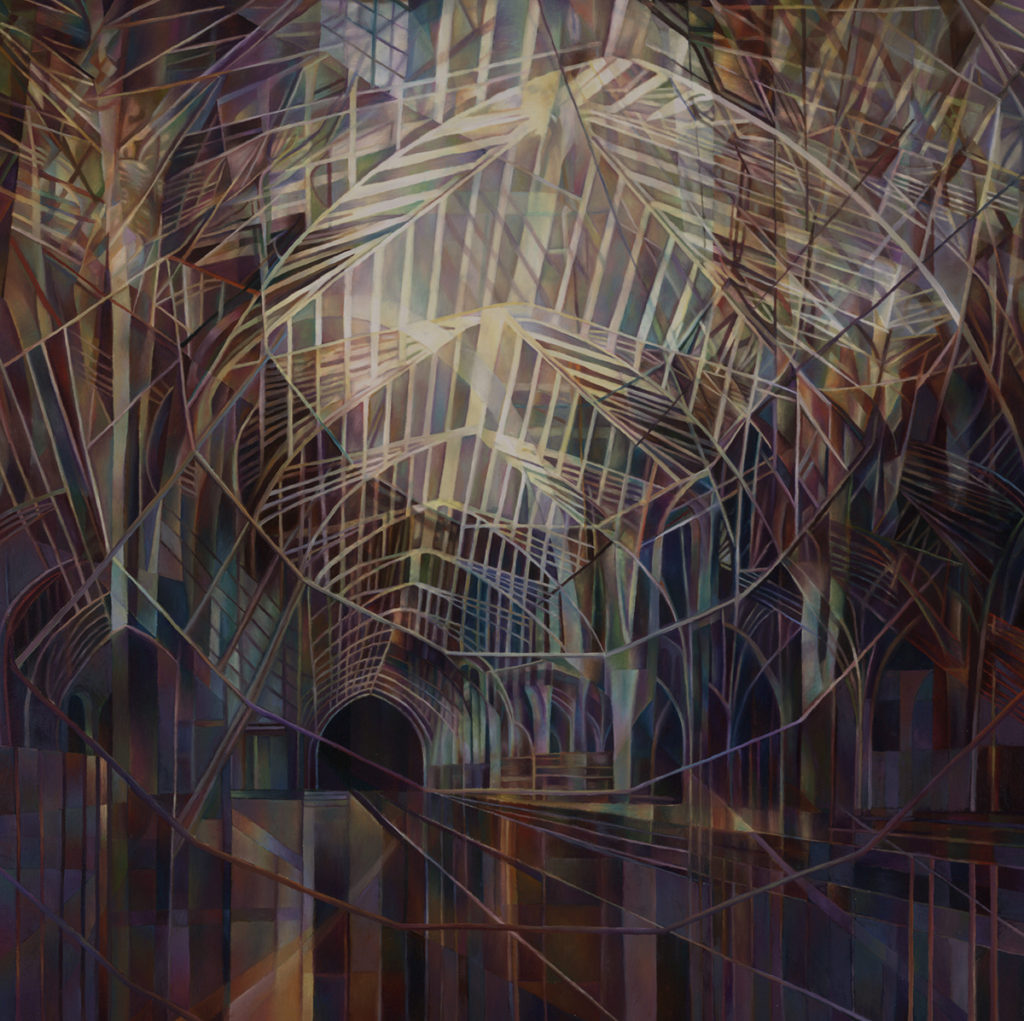
Ex Cathedral, 24×24″Oil on canvas
Contact details:
Nancy Newman Rice
Nancy Newman Rice, St Louis, USA
Interview by Deborah Blakeley, December 2018
Think a colleague or friend could benefit from this interview?
Knowledge is one of the biggest assets in any business. So why not forward this on to your friends and colleagues so they too can start taking advantage of the insightful information the artist has given?
Other artists you may be interested in:


